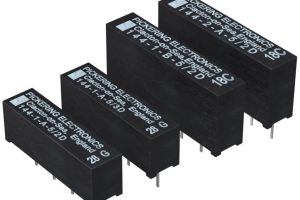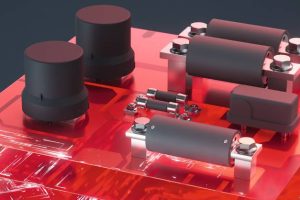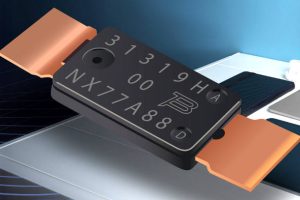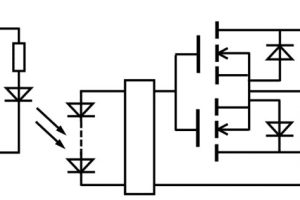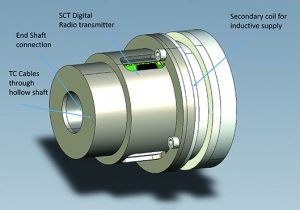
Figure 1: Telemetric data acquisition on a rotor shaft
In modern electric vehicles, different types of electric motors are available. Automobile manufacturers may select asynchronous or synchronous motors, and in some cases, they combine both motor types in one vehicle. In this context, synchronous motors are considered more efficient and have a higher efficiency than asynchronous motors.
Two types of synchronous motors are available: one requires external excitation of the rotor; and the second contains a permanent magnet. For a permanent magnet synchronous motor (PMSM) there is no need to power the rotor externally, making it more energy-efficient. In operation, however, currents caused by the motor’s operation limit its load capacity or can damage the permanent magnet installed in its rotor. The electrical polarisation of the magnets is weakened if the rotor temperature is too high. As soon as a certain threshold value, also known as the Curie temperature, is exceeded, the polarisation is completely lost, resulting in motor failure.
Measurement data
Controlling and managing the temperature development in a PMSM is therefore a critical factor in ensuring the performance of the motor and improving its efficiency when using it in an electric vehicle. To accomplish this, it is necessary to measure the energy flow and the temperature development of the motor. The measurement data obtained can be used to create a temperature model of the entire engine and integrate it into the thermal management system of the entire vehicle. In real operation, the temperature model ensures the best possible estimation of the rotor temperature to guarantee safe operation in all driving situations and ambient conditions.
Test bench challenges
To establish a basis for the thermal management of the synchronous motor, and to study, monitor and optimise it, electric motor development engineers record the rotor temperature while it is running on the test stand. This means that the measuring technology used must be as compact as possible and it must withstand high temperatures and materials. Despite the high ambient temperatures and high rotor speeds, precise measurement data is required. Against the background of the measurement task on the test bench, the measurement solution described here can be used in durability tests with or without a climatic chamber or can be used to create simulation models for the thermal management of engines.
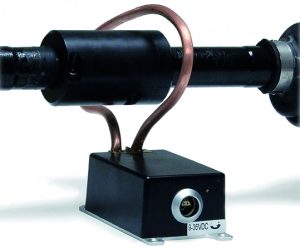
Figure 2: Inductive supply of the data acquisition in a shaft housing
Rotor temperature recording for electric vehicle motor validation is used on test benches. To accommodate measuring a running rotor, the data acquisition, a wireless telemetry system with an inductive power supply, is mounted directly on the rotor shaft. A universal telemetry data acquisition system, such as the compact and lightweight imc Dx, allows measurement data to be acquired on rotating components. (In addition to engines, the system can be used on rail vehicle wheelsets, vehicle axles and heavy duty winches.)
On the electric motor test stand, thermocouples are mounted in the rotor. The data acquisition leads are routed through the hollow shaft to the transmitter. The transmitter, located on the rotor shaft, is powered by an inductive ring stator. This allows continuous operation of the measuring solution, even in the climatic chamber. Data is transmitted by radio to an external receiver.
In confined measurement environments, such as a test bench, the transmitter unit’s small, lightweight housing facilitates adaptation to the test specimen. It measures at speeds up to 20,000rpm in a temperature range from -40°C to 125°C.
Digitisation of the data and transmission via the CAN field bus ensures constant signal quality, which contributes to the accuracy of the measurement data. In this case, the
imc Dx telemetry is configured externally via Ethernet so that no settings need to be made on the measurement hardware itself. Transmission frequencies are
available so that multiple telemetry transmitters can be used in parallel
in the same environment.
Electric motor development
Depending on the test environment and the task at hand, the imc Dx telemetry system can record other sensors on the rotating components in addition to the temperatures. This provides a measuring solution that helps developers to accurately visualise and overcome current challenges in developing electric motors.

Figure 3: The imc Dx telemetry in a shaft housing
Measurement data acquisition is becoming increasingly important as the demand for ever more compact and powerful electric motors raises physical and engineering issues. In the context of thermal management simulation models or test bench testing, high accuracy of measurement data is required. In terms of measurement technology, this can be achieved through compact, adaptable, flexible measurement systems, the use of wireless data transmission technologies and the use of materials that can withstand harsh environments.
 Electronics Weekly Electronics Design & Components Tech News
Electronics Weekly Electronics Design & Components Tech News
